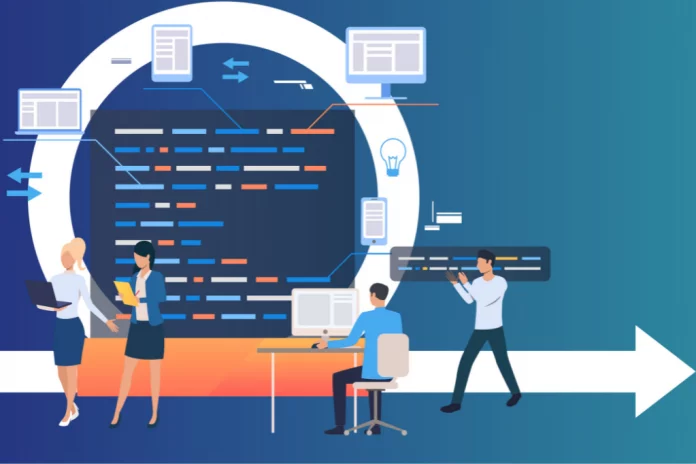What is open source ALM software?
ALM (Application Lifecycle Management) is a process that manages the lifecycle of a software application. Hence, it provides a method for specification, design, development, and software application testing.
Thus, it entails the whole lifecycle with the idea of an application right from the output, testing, deployment, support, and eventually user experience phase.
Therefore, depending on the software development approach, ALM might be divided into various phases. ALM mainly has three factors: Governance, development, and operations.
It is a combined system of people, devices, and processes supervising a software application from its primary planning through retirement.
By joining and assembling the parts of an application’s lifecycle, ALM enhances product quality, optimizes productivity, and facilitates the administration and maintenance of products.
Hence, its primary purpose is to document and trace the changes made to an application during its journey. For this, several ALM tools are available in the market.
Open Source ALM Software Application Life-cycle Framework
Stages of open source ALM software
Application lifecycle management consists of 5 steps:
- Defining requirements.
- Development of the product.
- Testing and quality assurance.
- Deployment.
- Constant maintenance and improvement of the product.
1. Defining requirements
All associates declare what they require from the application to support their business cases. Hence, a map of the application is created based on the stated needs. Terms can include a range of factors, from the business needs of the associates to agreement requirements.
Therefore, the requirements specification process is usually top-down, indicating the demands start with a declaration of the most common and proceed more precisely.
As a result, case elements are often in a hierarchical tree structure, with each node representing a more precise sub-requirement for the more common origin node.
However, other progress approaches, such as the iterative Agile development process, use limited hierarchical structures to list requirements, with the defined wants classified as use cases.
2. Development of the product
It begins once all elements have been established and allowed. In this stage, the product is induced from an idea and plan to an actual, working application.
Hence, the development team must split the application needs into parts and phases to create a development plan. Therefore, it is helpful to incorporate agents from all relevant groups during this time, including sales, product marketing, IT, and testing.
Therefore, it ensures that the built product meets all specified needs and is quite flexible. Hence, a wide range of development methodologies is available that one can use at this stage.
3. Testing and quality assurance
Testers need to begin preparing their test cases and testing environments before the product is formally open. Therefore, they should also be prepared to provide feedback on the application during development.
Furthermore, one has to include integration and unit tests in the programming activities. Development teams often use continuous integration systems.
Complete integration testing is ongoing at this time, and all problems or bugs discovered are reported and addressed by the development team.
Therefore, the developing and testing stages terminate when the product reaches a level of quality and stability that is good enough for release. The product marketing team defines this level.
4. Deployment
This stage includes the release of the product to users. Hence, it will differ based on the nature of the application under deployment.
Though each outcome will require different attributes and specifications, software as a service (SaaS) apps can be helpful on the company’s internal servers. In contrast, one can use web apps through the internet.
5. Constant maintenance and improvement of the product
This stage is to monitor and manage the performance of the produced application. Also, the lingering bugs are found and resolved, and new updates are prepared and prioritized.
Maintenance is usually the longest stage of open-source application lifecycle management, but it also requires the most negligible participation from the development team.
A vital element of the maintenance stage is determining the retirement of the system. In other words, organizations must choose the period at which products should be stopped and moved to a new version or switch to a different product entirely.
Benefits of open source ALM software
- High-visibility
- High-transparency
- Collaborative environment
- Real-time decision-making
- Strengthens testing practices
- Helps businesses plan more efficiently
What is the purpose of ALM?
The purpose of ALM is to provide the organization with a framework for software development and to help manage the software over time.
Hence, ALM methods use a lightweight, pre-established design and requirements to turn an idea into an application.
Why is ALM important?
The principal reasons for using ALM are as follow:
- Using ALM will have good visibility into project status.
- Teams can communicate effectively.
- It is easy to follow or set requirements.
- Software testing is appropriate.
- The cost of maintaining and operating the solution remains limited.
Conclusion
One can recognize a unification happening in the Application Lifecycle Management (ALM) markets. Traditionally organizations that built hardware devices are concerned with the components, assemblies, and parts that contain their products.
The tools used to maintain software and hardware products need to become more integrated.
Also Read:
TOP 7 OPEN SOURCE ALM (APPLICATION LIFECYCLE MANAGEMENT) TOOLS

